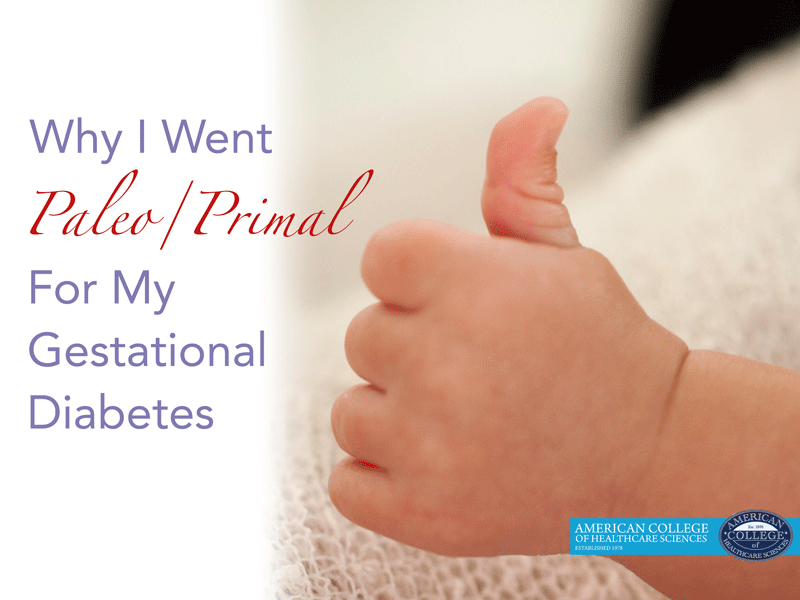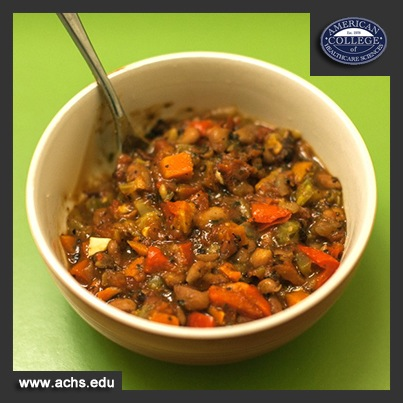I’ve been interested in Paleolithic (or paleo) diets for ages, but it always seemed difficult to give up my favorite croissants and ciabatta bread and fully embrace the lifestyle. Plus, I have a wheat-addicted daughter and husband to deal with. I’ve tried removing wheat from the house from time to time, but it usually results in some sort of mutiny and my dear hubby making panicked runs to Costco for massive packs of apple turnovers. I found him hiding some in his car last year and decided I may have been a wee bit extreme in my war on gluten.
However, I got a wake up call last year when I was diagnosed with gestational diabetes (GD) fairly early on in my recent pregnancy with our twins.
Gestational diabetes is much more common with twin pregnancies, but the diagnosis upset me. It seemed that getting a diagnosis of gestational diabetes triggered the five stages of grief! My first step was definitely denial: How could I possibly have gestational diabetes? I eat very healthy foods overall (well at least according to conventional holistic nutrition)—plenty of healthy whole grains, beans, legumes, organic vegetables, fruit, grass-fed beef, and organic chicken. Oh, and wild salmon of course—I do live in the Pacific Northwest! I also love my dark chocolate, but I’m more likely to make glucomannan pudding than cupcakes. (Okay, sometimes we have cupcakes.)
I was tested for gestational diabetes earlier in my pregnancy than most because of my symptoms (hyperemesis gravidarum, constant thirst, and needing to pee even more than the average pregnant woman) and the high risk of GD with twins. My test results were marginal, and it was still early, so, convinced this was all a giant mistake, I started monitoring my blood sugars four times a day to see if I could keep my gestational diabetes under control with diet and exercise.
Sure enough, the finger pricking four times a day revealed that my blood sugars were spiking! So then the next stage of grief was triggered—anger. At myself. And I wasn’t alone in my self blame: My gestational diabetes group was full of women blaming themselves for “causing” GD with those midnight ice-cream runs, penchant for fries, and failure to lose those “last ten pounds” before they got pregnant. I’d never had blood sugar issues before, even with prior pregnancies and my severe morning sickness meant the only thing I could keep down was a kale smoothie, so I got a little annoyed.
Risk Factors for Gestational Diabetes
Being an avid researcher, I turned that anger into a whole ton of PubMed searching. And I discovered that gestational diabetes strikes even the most ardent organic vegetable eater. It’s caused by the hormones from the placenta blocking the mother’s insulin response.
There are risk factors, including being overweight before you get pregnant, but many thin gals end up with GD, too. Some ethnicities are more likely to get GD, twins make it more likely, as does being of advanced maternal age, having a history of diabetes in the family, and polycystic ovary syndrome (PCOS). Alas, it seemed my risk factors (a few extra pounds, a few extra years, and twins) was enough to send my hormones into a stall. So if you found this post by Googling, “how did I cause gestational diabetes,” please don’t beat yourself up!
The next step in the process is usually bargaining, and I was no exception. I bargained with myself and the universe that I would follow the doctor’s recommendations to the letter and give my babies the healthy environment in utero they deserved.
I went off to meet with a gestational diabetes nutritionist (a lovely woman), who gave me what is apparently the standard GD advice. She emphasized that it was very important that I eat carbs and provided me with a strange suggested gestational diabetes menu plan that included nutritional horrors like eating a white bread roll with dinner. That threw me into the fourth stage of grief—depression! Was I really going to have to eat food that I usually avoid? Fortunately, that stage lasted for about five minutes before I moved onto acceptance. Even before GD, I never ate white bread rolls, so I’m certainly not going to add them when my little babies need all the nutrition they can get!
So rather than blindly following this strange and nutritionally bereft standard diet (which looked to be a fast trip to insulin dependency), I decided to do a little more research and see how I could tailor my usual holistic nutrition diet to deal with this curveball.
The Path to Paleo with Gestational Diabetes
Exercise right after eating helped, but my unique set of circumstances made even gentle walking a major challenge. Both my OB and the diabetes educator predicted I’d need high doses of glyburide (an antidiabetic drug) or even insulin to manage the GD as my pregnancy progressed.
Sure enough, following my standard holistic nutrition plan, with lots of unprocessed whole foods, including grains, my fasting numbers started to creep up. On week 28, the OB recommended we try a very small dose of glyburide at night to manage the fasting numbers. I was not keen—I think twice before taking an aspirin.
I was particularly worried since he said the tiny dose we started with would unlikely help for more than a week or two, and to double the dose if my fasting blood glucose went over 95 for three days in a row (a level between 70 and 100 milligrams per deciliter (mg/dL) is typically considered healthy).
But I was more worried about the negative effects for the babies of swimming in all that blood sugar, so I started the glyburide. It helped my fasting numbers drop down for about a week, then sure enough they started to creep up again.
So I decided to experiment a little bit. I started monitoring my blood sugar more. Before and after eating, middle of the night, and in 15-minute increments after eating certain foods.
Monitoring my blood sugar showed me something very intriguing. Anything with wheat spiked my blood sugar. Whole or white wheat made little difference. In fact, my favorite white ciabatta olive loaf had less of an effect than my organic Dave’s Killer Bread 21 Whole Grains and Seeds. Weird! And soaked oats (Nourishing Traditions-style fermented with some yogurt) spiked my blood sugar to nearly 200.
Whole-wheat pasta? Same deal. Even one-half cup shot me up to 180. Goodbye to my world-famous orzo pasta salad with summer vegetables and homemade pesto.
But I could eat ice cream with little effect on my blood sugar. Not low sugar either, but regular full-fat ice cream. How could ice cream be better on blood sugar than whole-wheat organic pasta? This really contradicted all my traditional holistic nutrition training and the way I’d been raised by my naturopath mum.
I know from my research that elevated blood sugar levels spike insulin and lead to stored fat. So how was it possible that my “healthy” grain choices were spiking my blood sugar so dramatically?
With my job, I’m super familiar with celiac and gluten intolerances, and have several friends who are gluten free. I’ve dabbled (gluten-free brownies are my fave!) but never felt much of a health change from even a month of gluten-free eating.
I’d heard of the book Wheat Belly, by Dr. William Davis, a while ago but hadn’t read it yet. Someone on this blog asked me about it, so I got a copy and read it. (Bed rest gives one lots of time to read and do research.)
I’d heard of many of the theories before. I’d even gone so far as to order heritage wheat from Bob’s Red Mill last year. I ground it myself and made bread at home to avoid the nasty hybridized wheat with high levels of gluten and gliadins. But Wheat Belly is a compelling read, and by the end of the book I was committed to try one month wheat-free and see how we all did.
Then I got a copy of Wheat Belly Total Health, which explained why my prior gluten-free months hadn’t had the stellar health benefits that I’d expected. I was simply replacing one grain with other grains, and none of them were good for my system.
Coincidentally, I was also working through human evolution with my daughter in social studies, including Paleolithic, Neolithic, and Mesopotamian history, so the dovetailing of all the information was intriguing.
Clearly my own experiences with my blood sugar monitoring, and that of others outlined in Dr. Davis’s book, indicated something was up. I do lose weight much easier on a low-carb diet, but I find them hard to stick to long term. (I could only “do” the Dukan Diet for three weeks before wanting to become vegan!)
So I decided since I was stuck on modified bed rest anyway, I may as well use the time to study up on other options. I can’t help it. I’m an education geek. So I signed up for the Primal Blueprint Expert Certification program (affiliate link) and started reading. I am a big fan of the Primal Blueprint paleo approach because it’s not super extreme and, apart from the no whole grains part, meshes pretty nicely with my upbringing in our naturopath household. Primal Blueprint okay’s dairy if you don’t have lactose intolerance (thankfully I don’t!) as long as it’s organic, and preferably raw and grass fed. (Remind me to write a blog about my Jersey cow experiment!)
And chocolate is Primal approved! (Dark chocolate, of course, but that’s my favorite kind anyway.) The Primal Blueprint includes plenty of carbs but in the form of sweet potatoes, starchy vegetables, quinoa, and chia seeds. I’ll share my favorite chocolate coconut chia seed pudding recipe in an upcoming blog—this stuff is absolutely delicious! So it’s not really a low-carb plan as such. Although, it often ends up with a lower carb count than the Standard American Diet (SAD) simply because it cuts out processed foods.
How to Eat Like a Cavewoman: Success with Primal Blueprint
I began to make some substitutions that meshed with the Primal Blueprint, like adding sweet potatoes to my dinner rather than brown rice. With the blessing of my high-risk OB, who was super impressed with how well my numbers were under control when I ate paleo or primal-style meals, it seemed to make sense to keep eating like a cavewoman.
I didn’t tell her that I was “going paleo,” but I gave her my food diary every week with all the foods I’d been eating, along with micro and macronutrients mapped out with nice little pie charts, and she was quite happy with my choices.
The fact that I track everything I eat in myfitnesspal and arrived with organized printouts (I put my blood sugar readings in the notes section) probably helped too. I find labels like “paleo” freak people out (allopathic doctors included), but the numbers speak for themselves.
First challenge: my birthday. With gestational diabetes, my choices were fairly limited. And no bubbly either since I don’t live in France where drinking while pregnant is recommended. So my darling daughter and I hunted down a decent looking paleo recipe on Pinterest, and she made me the most delicious paleo cake covered in dark chocolate ganache. I had two fairly large slices and my one-hour post eating (postprandial) number was 91. Amazing!
I cut out the half piece of whole-wheat toast that I’d been having with my eggs each morning. I’m lucky to get lovely eggs from our flock of pastured chickens and have a sweet hubby who was making me breakfast in bed each morning. Instead of the toast, I asked him to add a serving of vegetables to the eggs, whatever was easy from the night before was just fine. This added the requisite 15 grams of carbs, as I didn’t want to kick into ketosis when pregnant with twins!
Two days later, once all the cake was gone, I set my daughter to work on a paleo candy bar that I’d stumbled upon while surfing Pinterest. This paleo “Twix” bar seemed kind of sweet, so I wouldn’t eat it every day, but by golly it was delicious. Once again, it had very little effect on my blood sugars, giving me a one-hour postprandial reading of 108. (The goal is a reading under 140.)
We’re All Different: Take a Holistic Approach to Your GD
So why blog about my journey? Most people keep this kind of info private. But I’ve had quite a few questions about how I managed my gestational diabetes, and I did find out rather interesting information, and I thought I’d share my story in the hope that it might help someone else.
I’m not saying that everyone with gestational diabetes should go paleo. And of course you should work with your OB, perinatologist, endocrinologist, or diabetes educator as appropriate. But maybe experiment with what works for you. We’re all individuals, and the standard GD diet handed out by RDs seemed more inclined to send me down the path of needing high doses of medication and even insulin. It made me a little sad that my diabetes education specialist wasn’t even interested in my food diary when my numbers looked amazing!
Even if you don’t have gestational diabetes, if you’re showing any signs of pre-diabetes, or just want to avoid being one of the millions of Americans diagnosed with type II diabetes every year, now is the time to start a little human experimentation—on yourself.
Ask your doctor at your annual physical to test your A1C, which measures your average blood sugar levels over the last three months. Many consider the A1C test to be most accurate in measuring risk of developing diabetes and seeing how well existing diabetes is under control. Or talk to your doctor about testing your own blood sugar levels. (You can buy a blood sugar monitor on Amazon for $10-20 with a few testing strips and start looking at what spikes your blood sugar. It is absolutely fascinating! )
Now I’m committed to finding a way to get my family eating paleo. But maybe I’ll have to sneak it in subtly. If I keep finding such great meal choices, I’m pretty sure my meat-loving family will be happy as clams!
How to experiment on yourself:
- Always check with your obstetrician or doctor before making major changes to your diet, especially while pregnant! My diet was fairly paleo to start with, so cutting out a small amount of whole grains wasn’t too drastic a change for me, and my OB was happy with my eating plan. Your situation may vary.
- Gradual changes may be a good idea. And make sure you’re getting a good balance of macronutrients by substituting grains with sweet potato, quinoa, etc. Now is not the time to go full on Atkins. Diabetes educators will likely advise you to keep your carb levels between 120-150.
- Keep track of everything. I used myfitnesspal since my handwriting is awful, and I love the phone app. Include your blood sugar levels in your notes and conduct some analysis every day or two. I found that what I ate the day before had a significant impact on my numbers the following day.
- Make one tweak at a time. If you change two things, how will you know what worked?
Remember that I’m not a medical doctor nor a diabetes educator. I’m just a mama and an educator with a passion for holistic nutrition. And now a certified Primal Blueprint expert! Find my full bio here. (Just filter by Oregon.)
Interested in adding a Primal Blueprint Expert Certification to your ACHS credentials? Click here for more info (affiliate link).
Disclosure of Material Connection: I am the CIO of American College of Healthcare Sciences, the Institution that publishes this blog. However, all opinions are my own. This blog may contain affiliate links. I am disclosing this in accordance with the Federal Trade Commission’s 16 CFR, Part 255: “Guides Concerning the Use of Endorsements and Testimonials in Advertising.”
This article is for informational purposes only. It is not intended to treat, diagnose, cure, or prevent disease. This article has not been reviewed by the FDA. Always consult with your primary care physician or naturopathic doctor before making any significant changes to your health and wellness routine.
Resources
A1C Testing Information: https://www.niddk.nih.gov/health-information/diagnostic-tests/a1c-test







